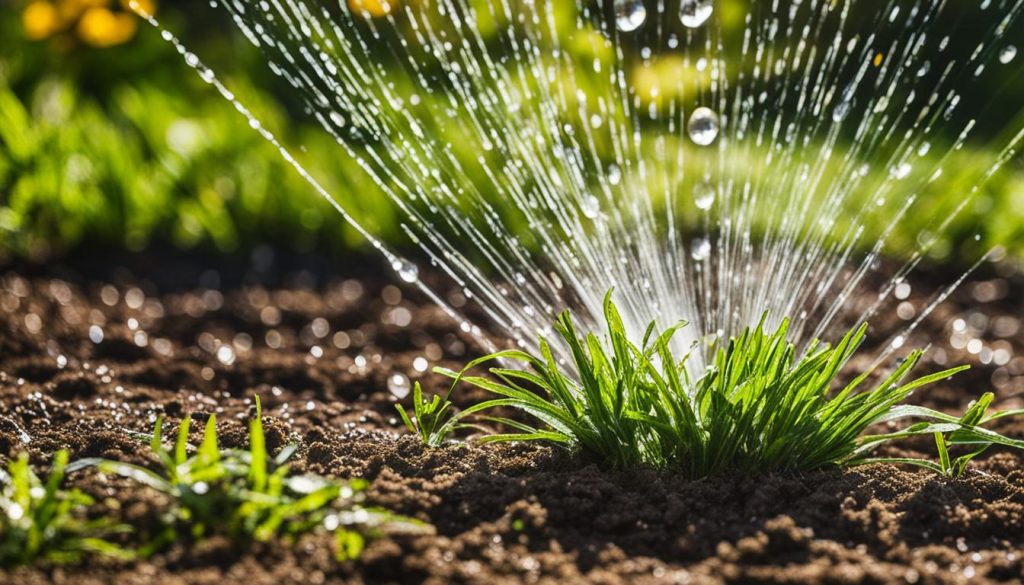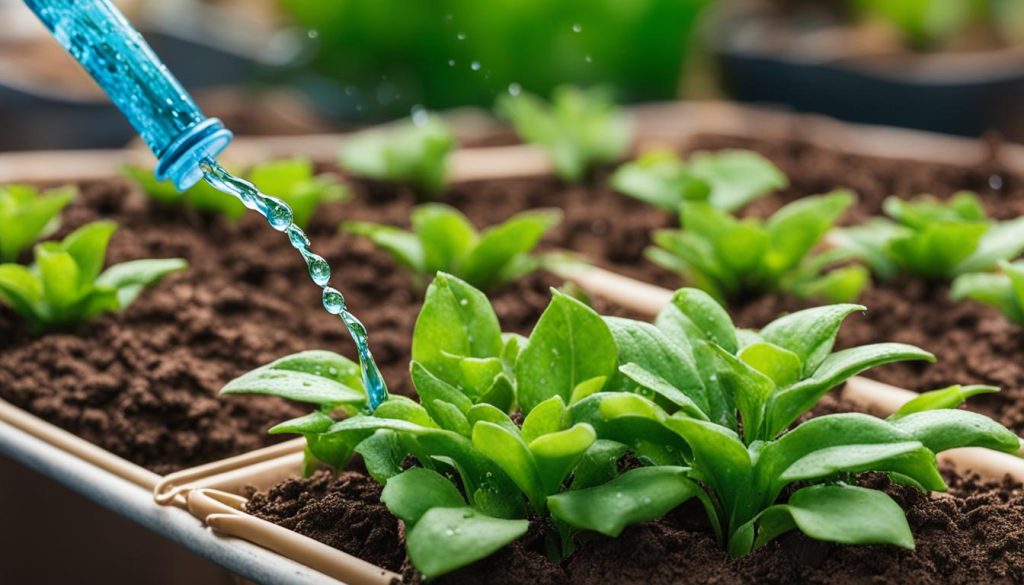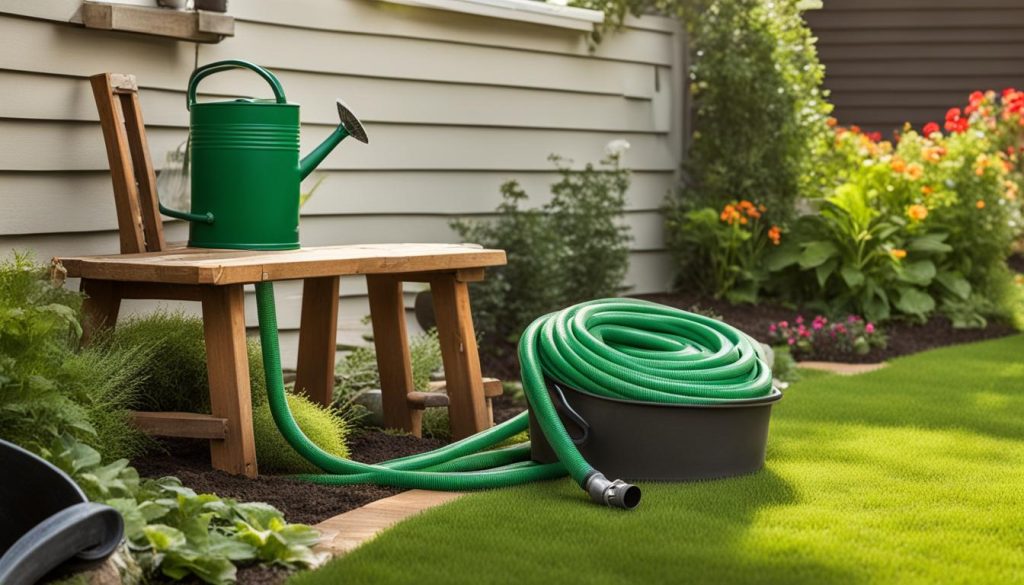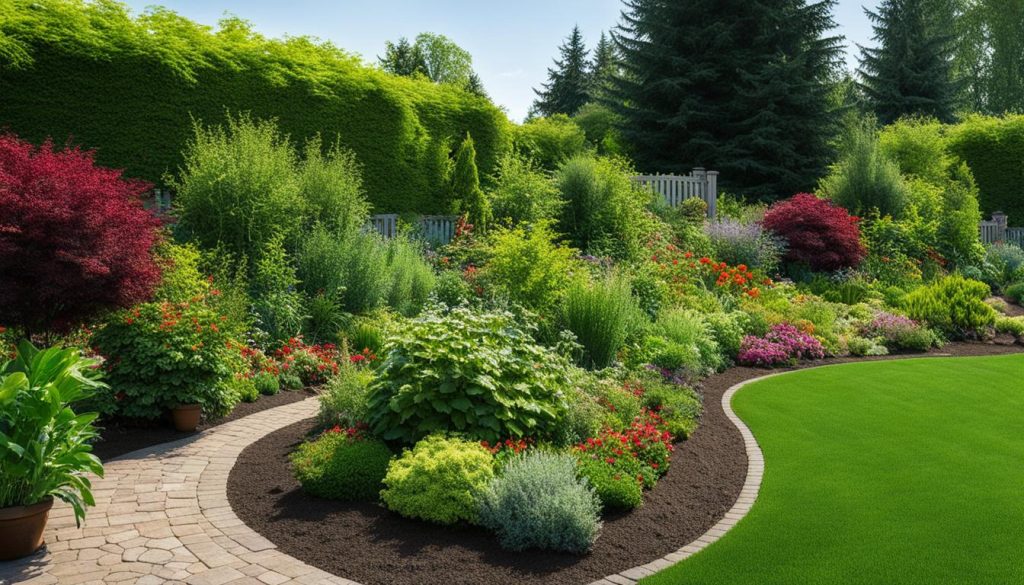As garden enthusiasts, we understand the importance of a lush and healthy landscape. However, we also recognize the crucial role that efficient water use plays in achieving this goal. This is especially true for Canadian gardens, where drought and water restrictions are becoming increasingly common.
By implementing smart watering techniques and understanding your landscape’s unique watering needs, you can ensure that your plants receive the right amount of water while minimizing waste. In this section, we will share our top watering tips to help you achieve efficient water use and maintain a beautiful garden.
Key Takeaways
- Efficient water use is crucial for the health of your garden and to conserve water.
- Understanding your landscape’s watering needs will help you determine how much water to use.
- Watering techniques such as drip irrigation and proper timing can reduce water waste.
- Smart watering solutions tailored to the Canadian climate can help you save water while maintaining a beautiful garden.
- Additional tips and tricks, such as monitoring soil moisture levels and using smart irrigation technology, can help optimize your water use.
Understanding Your Landscape’s Watering Needs
Before we delve into watering tips, it’s crucial to understand your landscape’s unique watering needs. Factors such as soil type, plant type, and weather conditions can influence how much water your landscape requires.
To assess your landscape’s watering needs, start by considering the soil type. Sandy soils tend to drain quickly, while clay soils retain water for longer periods. This means that sandy soils require more frequent watering, while clay soils can go for longer periods without water.
Next, take a closer look at the plants in your landscape. Plants with deep roots, such as trees and shrubs, can access water deeper in the soil, while plants with shallow roots, such as annuals and perennials, require more frequent watering.
Weather conditions also play a significant role in determining your landscape’s watering needs. During periods of high temperature and low humidity, plants lose water more quickly and require more frequent watering. On the other hand, if it’s been raining frequently, you may not need to water your landscape as often.
By taking into account these factors, you can develop a watering schedule that meets your landscape’s unique needs. This may involve watering certain plants more frequently than others or adjusting your watering schedule based on the weather forecast.
Assessing Soil Moisture Levels
One way to determine when to water your landscape is to assess soil moisture levels. To do this, insert a screwdriver or soil probe into the soil. If it goes in easily and the soil feels moist, you may not need to water yet. If, however, it’s difficult to insert the screwdriver or the soil feels dry, it’s time to water.

Another method to determine soil moisture levels is to use a soil moisture meter. These devices measure the moisture content of the soil and give you a reading, indicating whether the soil is dry, moist, or wet.
By understanding your landscape’s watering needs and assessing soil moisture levels, you can develop a watering schedule that promotes efficient water use and keeps your plants healthy.
Watering Techniques for Efficient Water Use
Efficient water use is crucial for maintaining a healthy landscape while conserving water. By using the right watering techniques, we can minimize water waste and ensure that our plants receive the appropriate amount of water. Below are some watering techniques that can help you achieve efficient water use in your Canadian garden:
Drip Irrigation Systems
A drip irrigation system is an excellent way to conserve water and ensure that your plants receive water directly at their roots. Unlike traditional sprinkler systems, drip irrigation systems deliver water slowly and directly to the soil, reducing water waste and minimizing soil erosion.

Mulching
Mulch is an essential component of any water-efficient garden. It helps retain moisture in the soil and prevents water from evaporating too quickly. By applying a layer of mulch around your plants, you can minimize water loss and promote healthy soil.
Proper Watering Times
The timing of watering can make a significant impact on water conservation. Water your plants early in the morning or late in the evening when temperatures are cooler, and the sun is not as strong. This will help prevent water from evaporating too quickly, allowing your plants to absorb the water they need.
Watering Methods
The way you water your plants can also impact efficient water use. Avoid using a high-pressure hose or sprinkler, as they can waste water through misting and runoff. Instead, use a watering can or a hose with a low-pressure attachment to deliver water directly to the soil.
By incorporating these watering techniques into your gardening routine, you can conserve water and keep your Canadian garden healthy and thriving.
Smart Watering Solutions for Canadian Gardens:
As Canadians, we understand the challenges that come with maintaining a beautiful garden while conserving water. Here are some smart watering solutions specifically tailored to Canadian gardens:
1. Choose Native and Drought-Resistant Plants
One of the best ways to reduce water usage in your garden is to choose plants that are native to Canada. These plants are adapted to the local climate and require less water than exotic plants. Additionally, consider selecting drought-resistant plants such as lavender, sedum, and yarrow. These plants are low-maintenance and can withstand dry conditions.

2. Use Rain Barrels
A rain barrel is a container that collects rainwater from your roof and gutters for use in your garden. By using a rain barrel, you can reduce your reliance on municipal water sources and conserve water. Place your rain barrel in a shaded area to prevent evaporation, and use the collected water to supplement your watering regimen.
3. Install Drip Irrigation Systems
Drip irrigation systems deliver water directly to the roots of your plants, reducing water waste and promoting efficient water use. These systems can be customized to fit different landscape layouts and can be adjusted to match the watering needs of different plants. By installing a drip irrigation system, you can save up to 50% on your water usage.
4. Mulch Your Garden Beds
Mulch is a layer of organic material such as leaves or bark that is placed over the soil in your garden beds. Mulch helps to retain moisture by reducing evaporation, and also helps to suppress weed growth. By applying a 2-3 inch layer of mulch around your plants, you can improve water retention and reduce your overall water usage.
5. Water in the Early Morning or Late Evening
Watering your plants during the hottest part of the day can cause rapid evaporation and water waste. Instead, water your plants in the early morning or late evening when the temperature is cooler. This will allow the water to seep into the soil and reach the roots of your plants without evaporating.
By implementing these smart watering solutions, you can maintain a beautiful garden while conserving water. Let’s do our part to ensure a sustainable future for our Canadian landscapes.
Additional Tips for Watering Success
We hope that the previous sections have provided you with valuable insights into efficient water use for your Canadian gardens. In this final section, we will share some additional tips and tricks to help you achieve watering success.
Monitor Soil Moisture Levels
One of the most important factors in achieving efficient water use is knowing when your plants need water. By monitoring the moisture level of your soil, you can determine when it’s time to water. There are many tools available to help you with this, such as moisture meters or simply digging a small hole to check the moisture level. Aim to keep the soil moist but not waterlogged, as overwatering can be just as harmful as underwatering.
Adjust Watering Schedules Based on Weather Conditions
Weather conditions can greatly affect the watering needs of your landscape. During hot and dry periods, your plants will require more water than during cooler and wetter periods. Adjust your watering schedule accordingly, and consider using rain sensors or weather-based irrigation controllers to automate this process.
Seek Professional Advice
If you’re unsure about the watering needs of a specific plant or are experiencing issues with your irrigation system, don’t hesitate to seek professional advice. A certified irrigation professional can provide guidance on efficient watering techniques and help you troubleshoot any problems.
Use Smart Irrigation Technology
Smart irrigation technology, such as soil moisture sensors and weather-based controllers, can greatly improve the efficiency of your watering system. These tools can automatically adjust watering schedules based on weather conditions and soil moisture levels, reducing water waste and ensuring your plants receive the right amount of water.
By following these additional tips and combining them with the techniques discussed in the previous sections, you can achieve optimal watering success in your Canadian gardens while conserving water.
If you have any questions, our team is always happy to help. Call us at (647) 812-8491.
FAQ
What are some watering tips for efficient water use in Canadian gardens?
We recommend watering your garden in the early morning or late evening to minimize evaporation. It’s best to water deeply and infrequently, allowing the water to reach the plant’s roots. Mulching around plants can also help retain moisture and reduce the need for frequent watering.
How can I determine the watering needs of my landscape?
Factors such as soil type, plant type, and weather conditions will influence your landscape’s watering needs. It’s important to assess these factors to determine the appropriate watering schedule. You can check the moisture level of the soil by sticking your finger into the ground. If the soil is dry a few inches below the surface, it’s time to water.
What are some efficient watering techniques I can use?
Using drip irrigation systems is one efficient watering technique as it delivers water directly to the plant’s roots, minimizing water waste. Mulching around plants can also help retain moisture and reduce evaporation. Additionally, watering during the cooler parts of the day, such as early morning or late evening, can help prevent water loss through evaporation.
How can I implement smart watering solutions in my Canadian garden?
To implement smart watering solutions in your Canadian garden, consider capturing rainwater in barrels or rain gardens for later use. Planting native and drought-resistant plants can also reduce water consumption. Additionally, using advanced irrigation systems that can be programmed based on weather conditions can help optimize water usage.
What are some additional tips for watering success?
Monitoring soil moisture levels regularly can help you adjust your watering schedule accordingly. It’s important to seek professional advice if you’re unsure about the watering needs of specific plants. Additionally, using smart irrigation technology, such as soil moisture sensors or weather-based controllers, can help automate and optimize your watering efforts.

